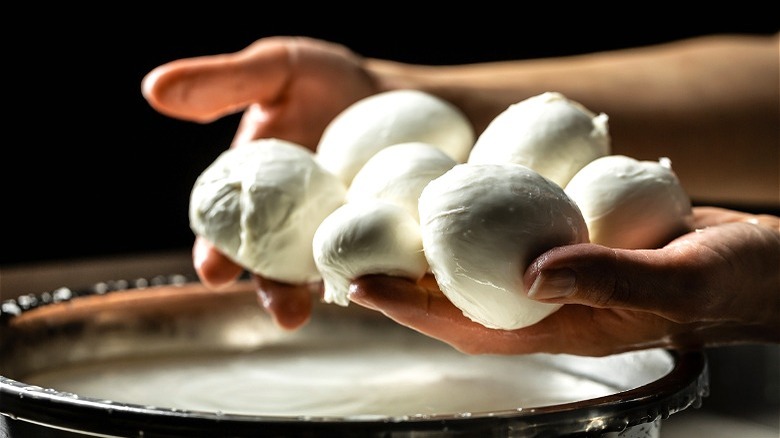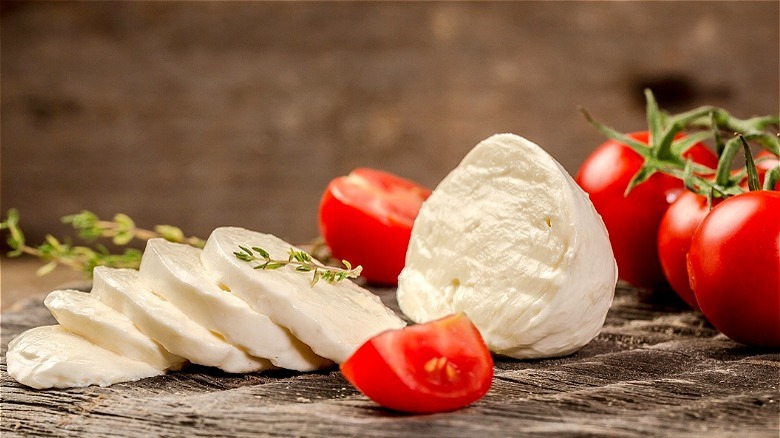The Secret To Using Fresh Mozzarella When Making Pizza
Can you name one person in your life that doesn't enjoy the chewy bread, seasoned sauce, and gooey cheese of a perfect slice of pizza? Rest easy if you can't since according to a 2019 survey conducted by Caulipower, over 95% of Americans eat pizza, with 54% claiming to love the layered pie. History states pizza was founded at some point during the 18th century in Naples, Italy but didn't become mainstream in America until after World War II when Italian immigrants moved outside the confines of city living into more rural and suburban neighborhoods.
Pivoting to present-day America and pizza has won the hearts of countless foodies. One 2021 survey conducted by Meatless Farm via OnePoll found that out of all the foods Americans can't live without, 40% of participants claim pizza to be the one food they could never leave behind (per Yahoo Life). The one ingredient that would certainly never be seen on the veritable list of worst pizza toppings is cheese. Research from Datassentials 2020 cheese and dairy SNAP! keynote report indicates that 87% of consumers believe cheese is important when crafting the perfect pizza and 85% chose mozzarella as their favorite (via Saputo Foodservice). But what is the difference between fresh and traditional mozzarella? Before breaking down how to use fresh mozzarella in your next homemade pizza, let's discuss what sets this variety apart from other types of mozzarella cheese.
Fresh mozzarella holds more moisture
Anyone who loves pizza enough is sure to be compelled at one point or another to make the most classic variety noted in history. Italian Food Company describes the long-established Neopolitan pizza as consisting of three definable ingredients: fresh mozzarella, basil, and tomatoes. What sets this prescribed fresh mozzarella cheese apart from other types comes down to moisture content. According to FoodUnfolded, mozzarella cheese as a whole is different from other types of cheese such as cheddar due to the stretching process that occurs in production. Known as "pasta filata," milk undergoes a fermenting and heating process followed by the addition of an animal-derived enzyme mixture called rennet. Rennet breaks down the milk's curds and changes the overall structure of the mixture until it transforms into malleable stretchy pieces of cheese.
The Italian Tribune claims mozzarella di bufala, made from buffalo milk, is the first and oldest form of mozzarella cheese, dating back to the 1100s. This variety is sold fresh in brine along with fior de latte mozzarella and they both contain a high level of moisture compared to the pizza cheese we have come to know and love. Saputo Foodservice describes traditional aged mozzarella as drier and more processed. Unlike fresh, aged mozzarella has a longer shelf life, firmer makeup, and significantly less moisture. Now that you know the main differences, what's the secret to using fresh mozzarella on your next homemade pizza?
Follow these steps before topping your next pizza with fresh mozzarella
While fresh mozzarella is often trumped by aged mozzarella when it comes to standard American pizza, fresh cheese is still a delicious option, especially if pizza Margherita is on the menu. But before adding hefty slices of that round soft ball of cheese to your next pie, Food Network suggests draining your mozzarella first. Cut fresh cheese into thin slices ahead of time and place them over a towel to soak up excess moisture. Giadzy recommends at least 15 minutes of draining time. This way your homemade pizza won't be covered in a pool of liquid once cooked. After 15 minutes, Giadzy suggests breaking apart your fresh cheese into smaller pieces before layering the torn pieces onto your pie — this way, you'll have fresh mozzarella in almost every bite.
Once you have successfully found the best method of draining fresh mozzarella, feel free to pair your beloved pie with all of your favorite toppings. The WebstaurantStore suggests pepperoni, basil, and Vienna sausage are some of the best accompaniments to your favorite Italian dish. Yet instead of the extra saltiness aged mozzarella usually provides (via Saputo Foodservice), you should expect to taste a creamier, slightly mild flavor thanks to fresh mozzarella cheese.


